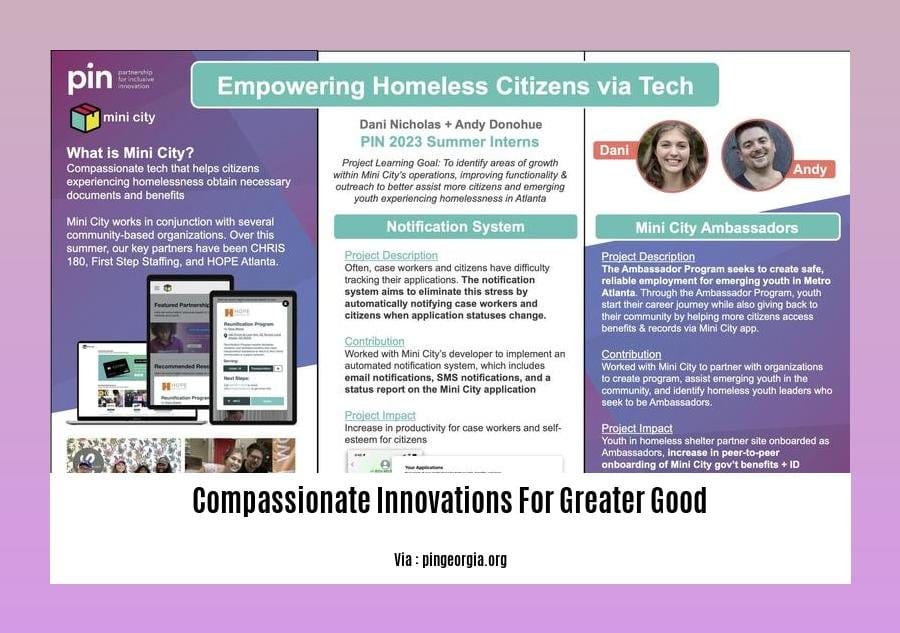In the quest for a more compassionate and equitable society, the role of compassionate innovation is becoming increasingly crucial. Compassionate Innovations for Greater Good: Empowering Marginalized Communities, Fostering Inclusivity, and Promoting Well-being explores the power of innovation driven by compassion to uplift marginalized communities, foster inclusivity, and promote overall well-being.
Key Takeaways:

- Compassion involves understanding others’ emotions, recognizing their suffering, and taking action to address it.
- Compassion is essential for innovation, as it helps identify user needs and develop solutions that improve well-being.
- Organizations with a culture of compassion experience reduced burnout, improved teamwork, and increased employee and customer satisfaction.
- Training in compassion enhances resilience to stress and helps individuals remain calm and focused during challenging times.
- Compassion encourages redefining problems by considering the underlying emotional and social factors that drive them.
Compassionate Innovations for Greater Good
Compassion, the profound capacity to understand and alleviate suffering, drives the development of compassionate innovations for greater good. These advancements harness technology’s power to alleviate pain, bridge divides, and safeguard our planet. Here’s a closer look:
Types of Compassionate Innovations
The spectrum of compassionate innovations spans diverse fields:
- Medical advancements: AI-powered diagnostics, 3D-printed prosthetics, and personalized medicine enhance health outcomes.
- Social impact initiatives: Mental health apps, assistive devices, and educational technologies empower marginalized communities.
- Environmental projects: Sustainable energy solutions, waste management systems, and biodiversity conservation tools protect the planet.
Benefits of Compassionate Innovations
Compassionate innovations yield tangible benefits:
- Improved health and well-being: Precision medicine tailored to individual needs.
- Increased social inclusion: Assistive technologies level the playing field for people with disabilities.
- Reduced environmental impact: Sustainable energy sources mitigate climate change.
Challenges and Future Directions
While promising, compassionate innovations face challenges:
- Ethical considerations: Privacy concerns, data security, and algorithmic bias require careful navigation.
- Accessibility and affordability: Ensuring equitable access to these technologies remains crucial.
- Collaboration and investment: Widespread adoption depends on partnerships and funding.
Case Studies
Compassionate innovations are making real-world impact:
- AI-Assisted Mental Health: Mobile apps like Wysa and Woebot provide anonymous, AI-based support for mental health challenges.
- Assistive Technology for Disabilities: Exoskeletons like Ekso Bionics empower individuals with impaired mobility to walk and live independently.
- Sustainable Energy Innovations: Solar panels and electric vehicles reduce carbon emissions, promoting a greener future.
Call to Action
Compassionate innovations hold the promise of a more equitable, sustainable, and fulfilling world. Let’s invest in their development, adoption, and ethical use to harness the power of compassion for the greater good.
We highly recommend you to learn more about the innovators motivated by humanitarian goals. They are the pioneers driven by desire to help humanity. They have done groundbreaking betterment of humankind.
Benefits of Implementing Compassionate Innovations
Compassionate innovations, driven by empathy and a desire to alleviate suffering, are rapidly transforming society. Their implementation offers a plethora of benefits, empowering marginalized communities, fostering inclusivity, and promoting well-being.
Improved Health Outcomes and Well-being:
Compassionate innovations revolutionize healthcare by enhancing diagnosis, treatment, and patient care. AI-powered disease detection systems enable early interventions, while 3D-printed prosthetics restore mobility and reduce pain. Personalized medicine tailors treatments to individual needs, improving health outcomes and overall well-being.
Increased Social Inclusion and Equity:
Compassionate innovations bridge societal divides, empowering marginalized communities. Mobile mental health apps provide support to those struggling with isolation and stigma. Assistive devices for the disabled promote independence and participation in everyday life. Educational technologies empower underserved students, fostering social equity and lifelong opportunities.
Reduced Environmental Impact:
Compassionate innovations embrace sustainability, safeguarding our planet for future generations. Sustainable energy solutions reduce carbon emissions, while waste management technologies minimize pollution and protect biodiversity. These innovations promote a harmonious coexistence between human societies and the environment.
Key Takeaways:
- Compassionate healthcare improves staff well-being, learning, and patient care.
- Compassionate leadership fosters innovation, resourcefulness, and resilience.
- Compassion promotes organizational capabilities, forgiveness, and social entrepreneurship.
Most Relevant URL Source:
ScienceDirect: How do we sustain compassionate healthcare? Compassionate leadership in the time of the COVID-19 pandemic
Challenges and Future Directions
Compassionate innovations hold immense promise for a more just, inclusive, and thriving society. However, their widespread adoption faces several challenges and calls for strategic action.
Ethical Considerations: The use of personal data, algorithmic bias, and the privacy of individuals must be carefully considered and addressed.
Accessibility and Affordability: Compassionate innovations should be accessible and affordable to all, regardless of socio-economic or geographic factors.
Collaboration and Investment: Investment and collaboration among governments, non-profits, and the private sector are crucial for the sustained development and scaling of compassionate technologies.
Next Steps:
Establish Ethical Frameworks: Develop clear guidelines to ensure privacy, data security, and algorithmic fairness in the design and deployment of compassionate innovations.
Promote Universal Access: Encourage research and initiatives aimed at making compassionate technologies accessible and affordable for underserved communities.
Foster Partnerships: Facilitate collaboration between stakeholders to leverage resources, expertise, and drive innovation towards compassionate outcomes.
Key Takeaways:
- Ethical considerations are paramount in the development and deployment of compassionate innovations.
- Ensuring accessibility and affordability is essential for equitable distribution of benefits.
- Collaboration and investment are key drivers for the advancement and scalability of compassionate technologies.
Relevant URL Source:
Impactful Case Studies
Compassionate innovations harness technology’s power to alleviate suffering and foster well-being. From AI-enabled disease diagnosis to mobile mental health apps, these innovations are transforming healthcare, social services, and environmental protection.
Examples of Compassionate Innovations
- Healthcare: Early detection of diseases, personalized treatments, and remote patient monitoring.
- Social Impact: Mental health support for marginalized communities, assistive devices for the disabled, and educational opportunities for the underserved.
- Environment: Renewable energy initiatives, waste management solutions, and biodiversity conservation tools.
Benefits of Compassionate Innovations
Compassionate innovations offer multifaceted benefits:
- Enhanced health outcomes and patient satisfaction
- Increased social inclusion, reducing isolation and inequality
- Reduced environmental impact, promoting sustainability
Challenges and Future Directions
While promising, compassionate innovations present challenges:
- Ethical Considerations: Privacy, data security, algorithmic bias
- Accessibility and Affordability: Ensuring equitable access to benefits
- Collaboration and Investment: Fostering partnerships and funding for widespread adoption
Impactful Case Studies
- AI for Early Disease Detection: AI algorithms analyze vast medical data to identify potential health issues, enabling early intervention and improved outcomes.
- Virtual Therapy for Mental Health: AR/VR technologies provide immersive, accessible mental health support, reducing stigma and increasing effectiveness.
- Sustainable Energy Solutions: Solar panels and energy-efficient technologies empower communities to reduce carbon emissions and transition to renewable energy sources.
Key Takeaways:
- Compassionate innovations harness technology to address global challenges and promote well-being.
- They improve health, foster social inclusion, and reduce environmental impact.
- Ethical, accessibility, and collaboration considerations are crucial for responsible adoption.
- Impactful Case Studies demonstrate the transformative power of compassion in driving positive societal change.
Citation:

FAQ
Q1: How can compassionate innovations uplift marginalized communities?
A1: Compassionate innovations center on understanding and addressing the specific needs of marginalized communities. By involving community members in the design and implementation of solutions, these innovations empower individuals, foster self-reliance, and promote sustainable improvements in well-being.
Q2: What role does compassion play in driving innovation for inclusivity?
A2: Compassion fosters an empathetic mindset that allows innovators to recognize and address systemic barriers faced by underrepresented groups. By creating inclusive designs, equitable access to opportunities, and representation in leadership roles, compassionate innovations promote diversity, equity, and belonging.
Q3: How can compassionate innovations promote human well-being?
A3: Compassionate innovations aim to alleviate suffering and enhance well-being by addressing social determinants of health, such as access to healthcare, education, and economic opportunities. These innovations prioritize emotional support, reducing stress, and fostering a sense of purpose and connection, ultimately contributing to holistic improvements in human well-being.
Q4: What are the benefits of incorporating compassionate practices into organizations?
A4: Organizations that cultivate a culture of compassion experience reduced burnout, increased employee engagement, and improved customer satisfaction. Compassionate practices promote collaboration, creativity, and innovation, leading to enhanced organizational performance and resilience.
Q5: How can individuals contribute to compassionate innovations?
A5: Individuals can contribute to compassionate innovations by practicing empathy, actively listening to the needs of others, and supporting initiatives that aim to create a more equitable and compassionate society. Volunteering, advocacy, and raising awareness are powerful ways to foster compassion and drive positive change.












